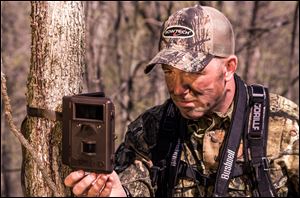
No sight goes unseen with trail cameras
9/21/2012
Once popular among hunters, trail cameras are starting to be used by gardeners and farmers, too.
Trail cameras are becoming as popular with gardeners and farmers as they are with hunters, who use them to monitor animal behavior.
These remotely operated devices can detect anything moving through orchards or fields in daylight or darkness, good weather or bad.
"The nature market is where our cameras were popular in the beginning, especially in Europe and the U.K.," said Darin Stephens, product manager for Bushnell (Corp.) Trail Cameras. "We're talking wildlife observers, scientists, and backyard naturalists.
"But they're also being purchased now by people who have just been planting things in their patch. They're seeing some incredible stuff."
That can include surprise wildlife species, such as mountain lions in territory where none was known to exist, or deer eating their fill in suburban vegetable beds.
Sometimes, the trail cams also record uninvited guests pilfering melons from gardens or siphoning gasoline from farm fuel tanks.
"A friend of mine has his set up to watch coyotes and other predators to safeguard his cattle herd," said Robert Good, a wildlife watcher from rural New Market, Va. "I use mine primarily to see what's out there that's not supposed to be there."
Unlike pocket cameras, motion-sensitive trail cams are remotely operated by infrared sensors and powered by batteries lasting up to a year. The small, weatherproof units come in cases that can be attached to fence posts, utility poles, and trees, or mounted a few feet above the ground near trails and ponds.
Images can be still, time-lapse or video, and many of the devices include audio. Newer models can transmit real-time images directly into computers. Prices vary from around $100 to more than $400.
These optical gatekeepers have come a long way since being introduced a few decades ago, Mr. Stephens said.
"We offered models with 1.3 megapixels [the number of parts in a digital image] when we started out," he said. "That was good enough for seeing what was getting into your garbage. We have 8-meg cameras now."
That magnitude of enhanced resolution delivers magazine-quality pictures. Their content has become the stuff of photo contests, Web sites, even new business ventures.
Jim Schoenike of Mequon, Wis., works in the investment service industry when he isn't bow hunting or stalking the state's forests and prairies. His trail-cam-generated wildlife pictures have become so popular that he has begun imprinting and selling them on calendars, note cards, and clothing (bigoakproducts.com ).
"You never really know what's out there," Mr. Schoenike said. "Looking at the memory card after the camera has been positioned for a while is like opening Christmas presents. I've come up with some uncommon pictures of bobcats when I've been expecting to see less cautious raccoons."
Capturing candid wildlife images requires more thought than simply stashing a trail cam in the woods, Mr. Schoenike said. Some suggestions:
e_SBlt"You need good quality light," he said. "I have a bias toward pointing my cameras toward the north to avoid getting any glare from the sun."
e_SBltRemove grass or tree limbs that might grow large enough to block sightlines or trip the camera if it's to be left unattended for long periods.
e_SBltLimit the time you spend around the remote setup to reduce or eliminate your scent. "Human scent spooks a good many animals," Mr. Good said.